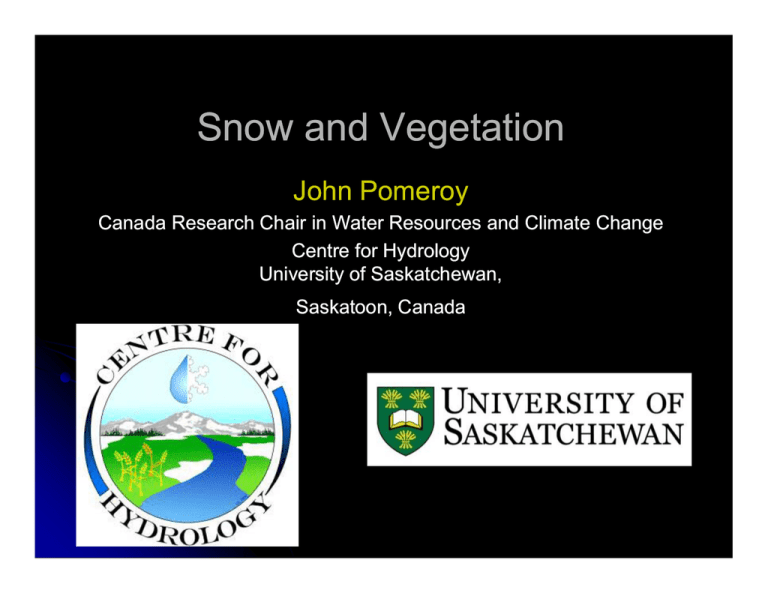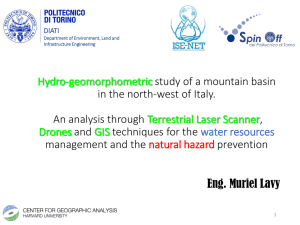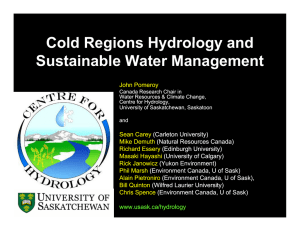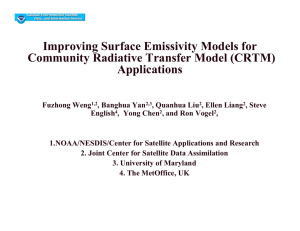Snow and Vegetation J h P John Pomeroy
advertisement

Snow and Vegetation J h P John Pomeroy Canada Research Chair in Water Resources and Climate Change Centre for Hydrology y gy University of Saskatchewan, Saskatoon, Canada Snow Dynamics z z z Snowfall Accumulation and Redistribution by Wind and Vegetation Snow Ablation by melt & sublimation Forest and shrub effects on accumulation and melt Snow Regimes F Forest t Snow S – O Open Snow S Blowing Snow Transport Over Complex T Terrain i QSUBLIM WINDWARD HILL, BARE GROUND, GROUND GRASS QTRANSP LEEWARD HILL, FOREST SHRUB, DEPRESSION BLOWING SNOW IF CAPACITY/THRESHOLD IS EXCEEDED WINDWARD HILL LEEWARD HILL QSUBLIM QSUBLIM QTRANSP Research Basins: • Wolf Creek • Marmot Creek TOPOGRAPHIC DEPRESSION BARE GROUND QTRANSP SHRUB GRASS FOREST Linear simulation of westerly flow over Wolf Creek, Yukon Windspeed Direction 3000 2500 2000 1500 1000 500 0 0 3 km Essery and Pomeroy, in preparation 500 1000 1500 2000 2500 3000 Simulation of Hillslope Snowdrift 3 km Distributed Blowing Snow Model Snowdrift Simulation 200 SWE (m mm) Observed 100 50 0 1420 Eleva ation (m) Simulated 150 0 100 200 300 400 300 400 H i Horizontal t l di distance t ((m)) 1400 1380 1360 1340 0 100 200 Horizontal distance (m) Snowmelt Rate z z z At a p point controlled by y energy inputs, snow internal energy and available snow mass Over some area controlled by the spatial distribution of snow mass (including snow covered area) and energy inputs Strong influence of topography and vegetation Coupled Mass and Energy Equations E ti for f Snowmelt S lt z MELT of SWE SWE, S = QM / λf z Melt Energy gy QM = Q* + QH – QE + QP – QG – dU/dt z z z z z z z Q* Net radiation (+ to snow surface) (=K↓ (=K↓-K↑+L↓K↑+L↓-L↑) QH Sensible energy (+ towards snow surface) QE Latent energy gy (+ ( awayy from snow surface)) QP Advected energy from precipitation (+ to snow) QG Ground heat flux (+ downward from snow) dU/dt Internal energy change (+ loss from melt) λf latent heat of fusion Real World Snowpacks Snow Exchange Realistic View z z Longwave exchange only at surface Penetration of shortwave K↓ K↑ L↓ P i it ti Precipitation L↑ QH QA z Air flow through porous structure z z z Convection Wind pumping Advection of energy from bare ground, plant stalks Ti QE Ts SNOWPACK QG dU/d dU/dt Melt Some Problems with Snowmelt Calculations z z z z z z Heterogeneity of atmospheric and radiative exchange Longwave exchange occurs at snow surface, shortwave exchange occurs in upper snow layers. Where are atmospheric exchanges occurring? Not only the snow surface Coupling between snow surface and internal energetics poorly understood. Mixture of “wet” wet snow preferential flow zones and impeding layers (~0 oC) and “cold” snow zones (<0 oC) Difficulty in coupling snow and frozen ground energetics, phase change and mass transfer f Turbulence generation mechanisms in mountains upper level winds strong shear zone transported turbulence valley winds tributary valley winds surface winds (internal B-L) flux tower in clearing QH = -ρ cp (Ts-Ta) f(u) QE = -ρ λs (qa-q*(Ts)) f(u), where surface saturated is at Ts Slope Forest Transmissivity τ a function of LAI, Foliage inclination C Crown coverage Slope, Aspect, Solar azimuth, Solar elevation South Face Forest 50 100 150 200 250 azimuth angle 300 350 25 40 55 70 0.0 0.1 0.2 0.3 0.4 0.5 0.6 0.7 0.8 0.9 10 Model of solar radiation transmission through continuous evergreen canopy on slopes elevation anglle 70 25 40 55 x 01 0.1 0.2 0.3 0.4 0.5 0.6 0.7 0.8 10 elevation anggle 85 85 North Face Forest 50 100 150 200 250 azimuth angle 300 350 Incoming Longwave in Mountains 30 Percent increase in longwave irradiance due to terrain emission due to sky view factor (Vf) and surface temperature (Ts). 25 Ts (°C) 20 Air temperature is 0°C and the clear sky emissivity is 0.65 15 10 5 0 0.5 0.6 0.7 0.8 0.9 1 Sk View Sky Vi F Factor t Vf Sicart et al. 2006 Hydrological Processes Thermal IR Image Wolf Creek shrrubs Marmot Creek leve el forest Solar radiation to snow beneath shrubs and trees 1000 400 SW (W/m ) 300 2 2 SW (W//m ) 800 600 400 200 0 123 200 100 0 124 125 74 Day (2003) Pomeroy et al., J Hydrometeorol, 2008 75 Day (2005) 76 Modelling Sub-alpine Shortwave Radiation Lidar and canopy delineation Shadow simulation Essery et al. (2007). Journal of Hydrometeorology. Upscaling Sub-alpine Shortwave Radiation Simulated skyview Simulated skyview Clear 600 Overcast Measured 2 SW (W/m ) 500 Modelled 400 300 200 100 0 84 85 Day y (2003) ( ) Essery et al. (2007). Journal of Hydrometeorology. 86 Hot Trees Longwave Exitance Pine Stand 350 330 Exiitance W/m²² 310 290 270 250 Needles 230 Trunk 210 190 Sky 170 Air 150 74 74.5 75 75.5 76 Julian Day 76.5 77 77.5 78 LiDAR Marmot Creek “honeycomb” clearings and spruce forest Valley 400 0.8 300 0.6 200 100 0.4 0 0.2 -100 -200 105 110 115 120 Day 125 130 135105 110 115 120 Day 125 130 0 135 Snow depth h (m) 2 Sensible Heatt (W/m ) S Plateau How Well Do Models Simulate Snow? Snowmip2 http://xweb.geos.ed.ac.uk/~ressery/SnowMIP2/results.html



